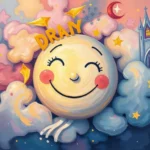
Have you ever awakened from a dream soaked in sadness, feeling as though a heavy weight has been placed on your heart? Dreams can sometimes serve as a mirror, reflecting our innermost feelings and concerns. When sadness creeps into our subconscious at night, it often signifies deeper emotional currents that need to be addressed. Understanding these dreams can be like peeling back layers of an onion, revealing insights about our emotional health and the challenges we face in waking life.
In this article, we will explore the symbolism behind dreams filled with sadness, examine real-life scenarios that might evoke such dreams, and ultimately discover how these experiences can lead to personal growth. Whether you’re grappling with a loss, feeling overwhelmed, or simply navigating the complexities of life, the wisdom hidden in these dreams can guide you toward healing and understanding.
Shadows of the Soul: Decoding Sadness in Dreams
To interpret dreams about sadness, we first need to recognize the symbols at play. Dreams often communicate through imagery and emotions, acting as a gateway to our subconscious thoughts. Here are some key symbols commonly associated with sadness:
-
Tears: Dreaming of tears can represent the release of pent-up emotions. It signifies a need to express feelings that you might be suppressing in your waking life. Crying in a dream can also indicate healing, suggesting that you are processing grief or loss.
-
Rain: Rain in dreams often symbolizes cleansing and renewal. However, if the rain feels heavy and unrelenting, it can reflect feelings of hopelessness or despair. This duality suggests that while you might be experiencing sadness, there is also potential for growth and transformation.
-
Empty Spaces: Dreaming of empty rooms or deserted places can indicate feelings of isolation or abandonment. It may highlight a disconnect from loved ones or a sense of loneliness in your waking life. These spaces often urge you to seek connection and community.
-
Darkness: Darkness in dreams often represents the unknown or fears that we may be avoiding. It can signify a struggle with depression or anxiety, inviting you to confront what lies beneath the surface of your consciousness.
-
Loss: Dreams involving the death of a loved one or the end of a relationship can evoke profound sadness. Such dreams may symbolize the fear of losing something significant in your life or the emotional turmoil you’re experiencing regarding a current situation.
Understanding these symbols can help you navigate the emotional landscape of your dreams. Remember, dreams don’t always have a singular meaning; they can be rich tapestries woven from various feelings and experiences.
Through the Veil of Tears: Scenarios of Sadness in Dreams
Let’s delve into some relatable scenarios that might evoke dreams filled with sadness. Each of these experiences sheds light on the emotional struggles many of us face, offering a glimpse into how they manifest in our dreams.
-
The Lost Loved One: Imagine dreaming of a cherished grandparent who has passed away. In the dream, you are having a heartfelt conversation, yet you wake up feeling a profound sense of loss. This dream could represent your ongoing grief and a desire for connection. It may be your subconscious’ way of inviting you to honor their memory and process your feelings.
-
The Failed Relationship: Picture a dream where you are reliving moments from a relationship that has ended. You feel a sense of longing and sadness as you revisit joyful memories tinged with pain. This scenario often reflects unresolved emotions and might suggest that you need to find closure or understanding regarding your feelings about the relationship.
-
The Overwhelming Workload: Consider a dream where you are drowning in paperwork, unable to keep up. The weight of the tasks feels insurmountable, and you wake up feeling stressed and defeated. This dream is a direct manifestation of your anxiety about your responsibilities. It serves as a reminder to reevaluate your commitments and prioritize self-care.
-
The Forgotten Friendship: Imagine dreaming of a close friend with whom you’ve lost touch. In the dream, you feel a deep sense of sadness over the distance that has grown between you. This dream may symbolize your desire for reconnection and the importance of nurturing relationships that have faded. It invites you to reach out and re-establish those bonds.
-
The Ominous Storm: Picture a dream where you’re caught in a storm, with dark clouds swirling around you. You feel helpless and scared, waking up with a lingering sense of dread. This dream often signifies internal turmoil and unresolved fears. It may be an invitation to confront what is troubling you and seek solace in self-reflection.
These scenarios can resonate powerfully, revealing how our emotions manifest in the dream world. They remind us that sadness, while often uncomfortable, is an essential part of the human experience that can lead to deeper insights.
From Heartbreak to Healing: Transforming Sadness into Growth
While dreams of sadness can be disheartening, they also provide an opportunity for personal growth. Here are some practical insights on how to harness the power of these dreams to foster emotional healing and resilience:
-
Journaling: Keeping a dream journal can help you process your feelings more effectively. Write down your dreams upon waking, noting any emotions, symbols, or recurring themes. Reflecting on these entries can reveal patterns and insights that guide you in your waking life.
-
Embrace Vulnerability: Allow yourself to feel your emotions fully. Whether it’s sadness, anger, or fear, acknowledging these feelings is the first step toward healing. Embrace vulnerability as a strength, and seek support from trusted friends or therapists who can help you navigate your feelings.
-
Practice Mindfulness: Engaging in mindfulness practices, such as meditation or yoga, can help you connect with your inner self. These practices encourage you to stay present, allowing you to explore your emotions without judgment. Mindfulness fosters a deeper understanding of your emotional landscape.
-
Creative Expression: Channel your feelings into art, music, or writing. Creative outlets can serve as powerful tools for expressing and processing sadness. Engaging in creative expression allows for the exploration of emotions in a constructive way, transforming pain into beauty.
-
Set Intentions for Healing: Use your dreams as a catalyst for change. After reflecting on your dreams, set small, actionable intentions that align with your emotional needs. Whether it’s reaching out to a friend or seeking professional help, taking proactive steps can empower you on your journey toward healing.
Incorporating these practices into your life can help you navigate the emotional complexities that arise from dreams about sadness. Remember, while sadness can feel overwhelming, it can also serve as a powerful teacher, guiding you toward a more authentic and fulfilling life.
As you reflect on your dreams of sadness, consider this: every tear shed in dreams and waking life is a testament to your capacity to feel deeply. Embrace the lessons that your dreams offer, for within the shadows of sorrow lies the potential for profound healing and transformation. Each dream is an invitation to delve deeper into your emotional world, paving the way for a brighter, more resilient future.







